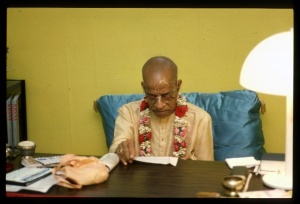SB 3.26.39: Difference between revisions
m (1 revision(s)) |
(Vanibot #0054 edit - transform synonyms into clickable links, which search similar occurrences) |
||
| (One intermediate revision by one other user not shown) | |||
| Line 1: | Line 1: | ||
{{info | {{info | ||
|speaker=Lord Kapiladeva the Supreme Personaliy of Godhead | |speaker=Lord Kapiladeva the Supreme Personaliy of Godhead | ||
|listener=Devahūti, mother of Lord Kapiladeva | |listener=Devahūti, mother of Lord Kapiladeva | ||
}} | }} | ||
[[Category:Srimad-Bhagavatam - Canto 03 Chapter 26]] | |||
[[Category:Bhagavatam Verses Spoken by Lord Kapila - Vanisource|032639]] | |||
<div style="float:left">'''[[Srimad-Bhagavatam]] - [[SB 3|Third Canto]] - [[SB 3.26: Fundamental Principles of Material Nature|Chapter 26: Fundamental Principles of Material Nature]]'''</div> | |||
<div style="float:right">[[File:Go-previous.png|link=SB 3.26.38]] '''[[SB 3.26.38]] - [[SB 3.26.40]]''' [[File:Go-next.png|link=SB 3.26.40]]</div> | |||
{{RandomImage}} | |||
==== TEXT 39 ==== | ==== TEXT 39 ==== | ||
<div | <div class="verse"> | ||
dravyākṛtitvaṁ guṇatā | :dravyākṛtitvaṁ guṇatā | ||
vyakti-saṁsthātvam eva ca | :vyakti-saṁsthātvam eva ca | ||
tejastvaṁ tejasaḥ sādhvi | :tejastvaṁ tejasaḥ sādhvi | ||
rūpa-mātrasya vṛttayaḥ | :rūpa-mātrasya vṛttayaḥ | ||
</div> | </div> | ||
| Line 16: | Line 22: | ||
==== SYNONYMS ==== | ==== SYNONYMS ==== | ||
<div | <div class="synonyms"> | ||
''[//vanipedia.org/wiki/Special:VaniSearch?s=dravya&tab=syno_o&ds=1 dravya]'' — of an object; ''[//vanipedia.org/wiki/Special:VaniSearch?s=ākṛtitvam&tab=syno_o&ds=1 ākṛtitvam]'' — dimension; ''[//vanipedia.org/wiki/Special:VaniSearch?s=guṇatā&tab=syno_o&ds=1 guṇatā]'' — quality; ''[//vanipedia.org/wiki/Special:VaniSearch?s=vyakti&tab=syno_o&ds=1 vyakti]-[//vanipedia.org/wiki/Special:VaniSearch?s=saṁsthātvam&tab=syno_o&ds=1 saṁsthātvam]'' — individuality; ''[//vanipedia.org/wiki/Special:VaniSearch?s=eva&tab=syno_o&ds=1 eva]'' — also; ''[//vanipedia.org/wiki/Special:VaniSearch?s=ca&tab=syno_o&ds=1 ca]'' — and; ''[//vanipedia.org/wiki/Special:VaniSearch?s=tejastvam&tab=syno_o&ds=1 tejastvam]'' — effulgence; ''[//vanipedia.org/wiki/Special:VaniSearch?s=tejasaḥ&tab=syno_o&ds=1 tejasaḥ]'' — of fire; ''[//vanipedia.org/wiki/Special:VaniSearch?s=sādhvi&tab=syno_o&ds=1 sādhvi]'' — O virtuous lady; ''[//vanipedia.org/wiki/Special:VaniSearch?s=rūpa&tab=syno_o&ds=1 rūpa]-[//vanipedia.org/wiki/Special:VaniSearch?s=mātrasya&tab=syno_o&ds=1 mātrasya]'' — of the subtle element form; ''[//vanipedia.org/wiki/Special:VaniSearch?s=vṛttayaḥ&tab=syno_o&ds=1 vṛttayaḥ]'' — the characteristics. | |||
</div> | </div> | ||
| Line 23: | Line 29: | ||
==== TRANSLATION ==== | ==== TRANSLATION ==== | ||
<div | <div class="translation"> | ||
My dear mother, the characteristics of form are understood by dimension, quality and individuality. The form of fire is appreciated by its effulgence. | My dear mother, the characteristics of form are understood by dimension, quality and individuality. The form of fire is appreciated by its effulgence. | ||
</div> | </div> | ||
| Line 30: | Line 36: | ||
==== PURPORT ==== | ==== PURPORT ==== | ||
<div | <div class="purport"> | ||
Every form that we appreciate has its particular dimensions and characteristics. The quality of a particular object is appreciated by its utility. But the form of sound is independent. Forms which are invisible can be understood only by touch; that is the independent appreciation of invisible form. Visible forms are understood by analytical study of their constitution. The constitution of a certain object is appreciated by its internal action. For example, the form of salt is appreciated by the interaction of salty tastes, and the form of sugar is appreciated by the interaction of sweet tastes. Tastes and qualitative constitution are the basic principles in understanding the form of an object. | Every form that we appreciate has its particular dimensions and characteristics. The quality of a particular object is appreciated by its utility. But the form of sound is independent. Forms which are invisible can be understood only by touch; that is the independent appreciation of invisible form. Visible forms are understood by analytical study of their constitution. The constitution of a certain object is appreciated by its internal action. For example, the form of salt is appreciated by the interaction of salty tastes, and the form of sugar is appreciated by the interaction of sweet tastes. Tastes and qualitative constitution are the basic principles in understanding the form of an object. | ||
</div> | </div> | ||
__NOTOC__ | |||
<div style="float:right; clear:both;">[[File:Go-previous.png|link=SB 3.26.38]] '''[[SB 3.26.38]] - [[SB 3.26.40]]''' [[File:Go-next.png|link=SB 3.26.40]]</div> | |||
__NOTOC__ | |||
__NOEDITSECTION__ | |||
Latest revision as of 21:48, 17 February 2024

A.C. Bhaktivedanta Swami Prabhupada
TEXT 39
- dravyākṛtitvaṁ guṇatā
- vyakti-saṁsthātvam eva ca
- tejastvaṁ tejasaḥ sādhvi
- rūpa-mātrasya vṛttayaḥ
SYNONYMS
dravya — of an object; ākṛtitvam — dimension; guṇatā — quality; vyakti-saṁsthātvam — individuality; eva — also; ca — and; tejastvam — effulgence; tejasaḥ — of fire; sādhvi — O virtuous lady; rūpa-mātrasya — of the subtle element form; vṛttayaḥ — the characteristics.
TRANSLATION
My dear mother, the characteristics of form are understood by dimension, quality and individuality. The form of fire is appreciated by its effulgence.
PURPORT
Every form that we appreciate has its particular dimensions and characteristics. The quality of a particular object is appreciated by its utility. But the form of sound is independent. Forms which are invisible can be understood only by touch; that is the independent appreciation of invisible form. Visible forms are understood by analytical study of their constitution. The constitution of a certain object is appreciated by its internal action. For example, the form of salt is appreciated by the interaction of salty tastes, and the form of sugar is appreciated by the interaction of sweet tastes. Tastes and qualitative constitution are the basic principles in understanding the form of an object.